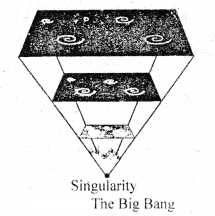Detailed, Step-by-Step NCERT Solutions for Class 11 Geography Chapter 2 The Origin and Evolution of the Earth Questions and Answers were solved by Expert Teachers as per NCERT (CBSE) Book guidelines covering each topic in chapter to ensure complete preparation.
The Origin and Evolution of the Earth NCERT Solutions for Class 11 Geography Chapter 2
The Origin and Evolution of the Earth Questions and Answers Class 11 Geography Chapter 2
Multiple Choice Questions
Question 1.
(i) Which one of the following figures represents the age of the earth?
(a) 4.6 million years
(b) 13.7 billion years
(c) 4.6 billion years
(d) 13.7 trillion years
Answer:
(c) 4.6 billion years.
(ii) Which one of the following has longest duration?
(a) Eons
(b) Period
(c) Era
(d) Epoch
Answer:
(b) Period.
![]()
(iii) Which one of the following is not related to the formation or modification of the present atmosphere?
(a) Solar winds
(b) Differentiation
(c) Degassing
(d) Photosynthesis
Answer:
(a) Solar winds.
(iv) Which one of the following represents the inner planets?
(a) Planets between the sun and the earth
(b) Planets between the sun and the belt of asteroids
(c) Planets in gaseous state
(d) Planets without satellite(s)
Answer:
(b) Planets between the sun and the belt of asteroids
(v) Life on earth appeared around how many years before the present?
(a) 13.7. billion
(b) 4.6 billion
(c) 3.8 ihillion
(d) 3.8 billion
Answer:
(d) 3.8 billion.
![]()
Question 2.
Answer the following questions in about 30 words each :
(i) Why are the terrestrial planets rocky?
Answer:
Mercury, Venus, Earth and Mars are known as terrestrial planets,They are rocky because they are made up of rocks and metals and have relatively high densities.
(ii) What is the basic difference in the arguments related to the origin of the earth given by
(a) Kant and Laplace, and
(b) Chamberlain and Moulton?
Answer:
(a) Kant and Laplace gave Nebular Hypothesis. The planets were formed out of a cloud of material associated with a youthful sun, which was slowly rotating.
(b) Chamberlain and Moulton – A wandering star approached the sun. As a result, a cigar shaped tongue of material was separated from the solar surface. As the passing star moved away, the material separated from the solar surface continued to revolve around the sun and it slowly condensed into planets.
(iii) What is meant by the process of differentiation?
Answer:
After the formation of earth, due to immense heat the earth became partially molten. The lighter and denser materials on melting mixed and got separated depending on their densities. This allowed the separation of heavier and lighter materials called differentiation. During the formation of moon, due to the giant impact, the earth was further heated up leading to the next phase of differentiation. .Through the process of differentiation, earth got separated into different layers.
(iv) What was the nature of the earth’s surface initially?
Answer:
The earth has a layered structure. From the outermost end of the atmosphere to the centre of the earth, the material that exists is not uniform. The atmospheric matter has the least density. From the surface to deeper depths, the earth’s interior has different zones and each of these contains materials with different characteristics.
![]()
(v) What were the gases which initially formed the earth’s atmosphere?
Answer:
The planet earth initially was a barren, rocky and hot object with a thin atmosphere of hydrogen and helium. This is far from the present day picture of the earth.
Question 3.
Answer the following questions in about 150 words.
(i) Write an explanatory note on the ‘Big Bang Theory’.
Answer:
In the present world, the most popular argument regarding the origin of the universe is the ‘Big Bang Theory’. This is also called “expanding universe”. The Big Bang theory considers the following stages in the development of the universe :

(ii) In the beginning all matter forming the universe existed in one place in the form of a ‘tiny ball’ with a small volume, infinite temperature and infinite density.
(ii) At the Big Bang the ‘tiny ball’ exploded violently. This led to a huge expansion. The expansion continues even to present day. As it grew, some energy was converted into matter. There was particularly very rapid expansion within fractions of a second after the bang. Thereafter, expansion has slowed down. Within first three minutes from the Big Bang event, first 1 atom began to form.
(iii) Within 300,000 years from the Big Bang, temperature dropped to 4500°K and gave rise to atomic matter. The universe becametransparent.The expansion of universe means increase in space between the galaxies.
(ii) List the stages in the evolution of the earth and explain each ‘ stage in brief,
Answer:
Evolution of the Earth (Development of layered structure):
Initially earth was a barren, rocky and hot object with a thin atmosphere of hydrogen and helium. There must have been some events processes, which may have changed the earth from a rocky, barren and hot place to a beautiful planet. The earth has a layered structure. The material existing on the earth, from centre to the end of atmosphere, is not uniform. Earth’s interior has different zones and each of them contains materials with different characteristics.
![]()
Development of layered structure :
- Many planetesimals moved together to form planets.
- The mass forming the earth, collect through gravitation, and had impact on the existing materials. The impact generated lots of heat which caused melting of the materials. This occurred after the formation of the earth.
- Due to this heat, the earth became partially molten and the heavier and denser materials got separated. This allowed heavier materials to sink towards the centre and lighter towards the surface. This process is called differentiation.
- During the formation of Moon, due to the giant impact, the earth was further heated up and got separated into different layers. Starting from the surface to the eentral parts, we have layers like crust, mantle, outer core and inner core.